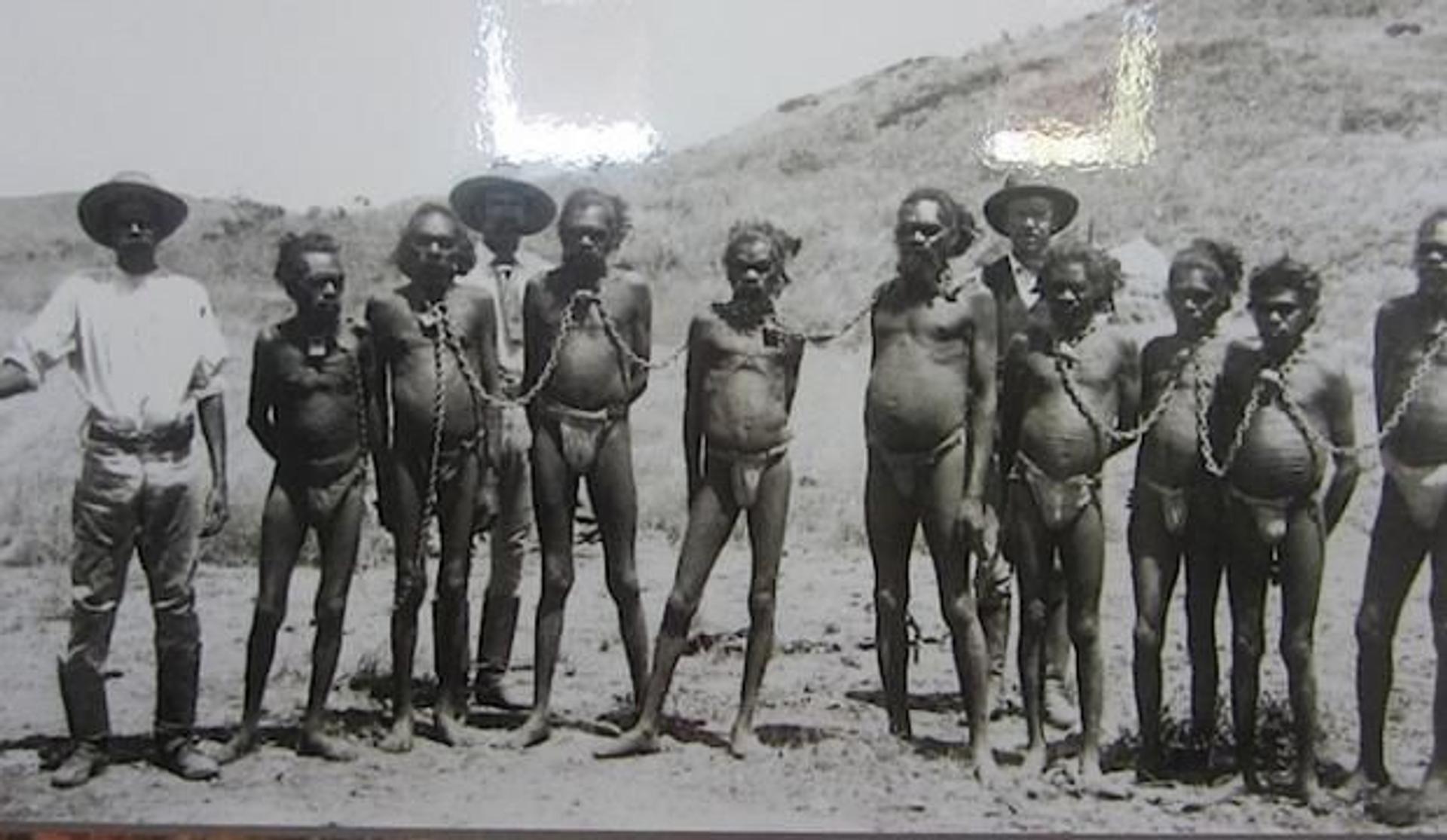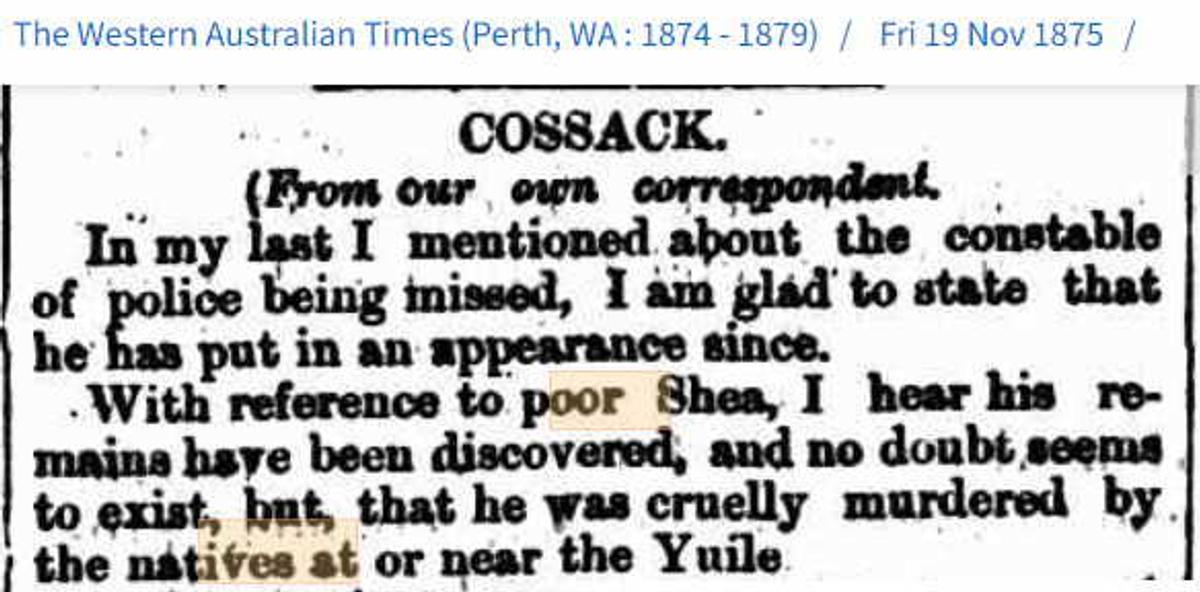John Shea and Frederick Cooper
Vessel Name: Sea Spray
John Shea and Frederick Cooper
Murdered at Yule River; bodies recovered
5 September 1875
Cultural content warning - this story contains content about blackbirding and historical racism. FLatSea attempts to present history as it happened, and we acknowledge some of our history is culturally disturbing to some readers.
Our memorial trail exists to honour our lost fishers and their contribution to our life in Western Australia today. Out of respect for the First Nations People affected by blackbirding, it is our decision to omit the characters in this story from the memorial trail.



John Shea was born in Ireland in 1829. He migrated to Australia at the age of 23 years. His brother Robert had migrated to Western Australia and entered the lucrative pearling industry. John followed his brother to the northwest of Western Australia, and both brothers were based in Roebourne in the Pilbara region. John was married to Mary Dunne, who was also Irish.
Robert owned the pearling schooner Sea Spray and John worked aboard with his brother. She was built by William Jackson in Fremantle in 1862 for use as a pearling boat and coastal courier. Sea Spray was the first boat built in 1862, and her official number was 36546. She was the biggest of her kind when she was built. She was a fast two-masted schooner built for the pearl industry and coastal trade work. She was 50.7 feet long [15.45 metres], 15.1 feet wide [4.6 metre] and drew 7.1 feet [2.16 metres].
From 1864 Robert Shea operated Sea Spray as a pearl boat, but she had a dark sideline in the blackbirding trade. Robert and John used Sea Spray to take Aboriginal people and hold them prisoner, selling them to other pearlers for diving work. In 1872 Robert Shea and Sea Spray’s mate Samuel Miller were murdered by some Aboriginals who had absconded from the boat. [See the Robert Shea and Samuel Miller story].
John also was a part owner of the Rose, another two-masted top sail schooner of 93.53 tons. She was built by Robert Wrightson of Fremantle in 1869. Her official number was 61086. She measured 86.5 x 21 feet and drew 8.17 feet of water. [26.36 x 6.4 x 2.49 metres]. Rose was owned by a cooperative of which John was a part. She had an interesting international career in the sandalwood trade. She held the record for the fastest voyage to and from China. She was also able to transport diving crews from southeast Asia.
Rose was usually under the command of John Ferguson or Andrew Reid, master mariners and part owners of the vessel. John had various working partnerships, including a pearling partnership with McKenzie Grant, who was a notable landowner and settler of the DeGrey River region.
John continued blackbirding on the Sea Spray after his brother’s demise. After she was lost in 1873, he transferred his illegal practice to the Rose, although he also used other vessels. He kept prisoners ashore in barracoons, including Barrow Island. At the end of October 1875, he put some Aboriginal men ashore at the Yule river mouth, but the following day he could not find them. Assuming they had escaped, John took Frederick Cooper, his European-Aboriginal mate and went to find them.
On 1 September 1875 John and Fred succeeded in finding the Njamal men that had run away from him and started to take them back to the coast. The men escaped again and headed towards the main camp of their people. This time when John and Fred caught up with them, they were met with resistance from a larger number of Njamal men and violence ensued.
John and Fred were overcome. According to witnesses from the tribal men, two men held John’s legs, two held his arms and another two held his waist. He was thrown on the ground, and two more men sat on his chest. Men beat John’s head with small sticks until he died. Then Fred was killed in the same way. The bodies were left where they died.
John had hired horses and taken one day of provisions, setting out along the Yule River. The horses found their way back to the saddlery in Roebourne, one had its saddle missing. Fourteen days later, he had not returned. Given the history of his brother’s murder and the knowledge of John’s ill-treatment of the Njamal people, his failure to return spelled out concern he had met a similar fate to that of his brother.
Police Sergeant Richard William Vincent from Roebourne took a party to search for John. They followed his tracks inland, along the Yule River, where they found his body located approximately 40 miles [64 kms] from McKay’s Station.
John had been left lying on his back, and although the body was decomposed, it was evident he met death through violence. His jaw was broken with teeth knocked out. The skull was damaged in several places. There were sticks lying around that were covered in blood. The tracks around the body led the search party to Frederick Cooper’s body. Sergeant Vincent ordered the bodies be buried where they were found at Yule River.
The search party continued inland and located a group of Njamal men, one of whom was wearing John’s hat. The men acknowledged they had killed John and Fred in retaliation for their imprisonment. They said John told them they would work on a cattle station, but he was forcing them to go to sea. When they ran away, John followed them to take them back and there was a fight.
There was also an unforgotten matter of a young lad on board the pearling cutter Prince of Wales. John had been charged with indecently dealing with the 14-year-old boy in February 1874.There was a trial. John plead not guilty, and the Crown abandoned the prosecution. The judge instructed the jury to return a verdict of not guilty. John was acquitted and the charge was dismissed.
Sergeant Vincent arrested four Njamal men for the murder of John and Fred. They were taken back to Roebourne for trial. They had no legal counsel, although Mr Viveash junior was employed as an interpreter for the court.
Sergeant Vincent reported John Shea went missing from Roebourne settlement in August 1875, and his search party found John and Fred’s body, which showed evidence of his violent death. Via witnesses the Crown heard of John’s treatment of men and women he forced into pearl diving. The accused, through the interpreter said they had killed John and Fred in retaliation for their treatment of them.
Having heard the details of events leading up to the murders, the Crown Solicitor said the court had only the accused’s translated admissions as admissible evidence. He advised the Court he would be “glad to retire from the case”. The Resident Magistrate decided that to keep the peace and deliver social jurisprudence, the jury should return a verdict of not guilty. The Njamal men were dismissed from the courthouse.
The Shea men and their blackbirding ways were ignominiously resigned to the annals of history.
John’s estate was left to his wife Mary. Probate was completed in December 1875, and Mary was the sole beneficiary.
The Sea Spray ended her dubious career in 1873. She was leaky, her pumps did not work, and she was in poor repair. Her final voyage was made from Port Walcott to Condon with a turnaround back to Port Walcott. She struck a bank in Condon Creek and sank with all souls aboard. The deceased mate Miller’s younger brother was aboard and was lost with her.
Rose’s working life ended on 4 September 1876.She had been weakened in 1873 when she was driven onto the beach with her anchors dragging. She was repaired and carried on working. In 1876 she was wrecked on North Danger Reef in the China Sea carrying sandalwood.
